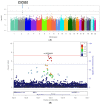A Genome-Wide Association Study of Idiopathic Dilated Cardiomyopathy in African Americans
- PMID: 29495422
- PMCID: PMC5872085
- DOI: 10.3390/jpm8010011
A Genome-Wide Association Study of Idiopathic Dilated Cardiomyopathy in African Americans
Abstract
Idiopathic dilated cardiomyopathy (IDC) is the most common form of non-ischemic chronic heart failure. Despite the higher prevalence of IDC in African Americans, the genetics of IDC have been relatively understudied in this ethnic group. We performed a genome-wide association study to identify susceptibility genes for IDC in African Americans recruited from five sites in the U.S. (662 unrelated cases and 1167 controls). The heritability of IDC was calculated to be 33% (95% confidence interval: 19-47%; p = 6.4 × 10-7). We detected association of a variant in a novel intronic locus in the CACNB4 gene meeting genome-wide levels of significance (p = 4.1 × 10-8). The CACNB4 gene encodes a calcium channel subunit expressed in the heart that is important for cardiac muscle contraction. This variant has not previously been associated with IDC in any racial group. Pathway analysis, based on the 1000 genes most strongly associated with IDC, showed an enrichment for genes related to calcium signaling, growth factor signaling, neuronal/neuromuscular signaling, and various types of cellular level signaling, including gap junction and cAMP signaling. Our results suggest a novel locus for IDC in African Americans and provide additional insights into the genetic architecture and etiology.
Keywords: African American; CACNB4; GWAS; calcium channel; heart failure; idiopathic dilated cardiomyopathy.
Conflict of interest statement
The authors declare no conflict of interest.
Figures


References
-
- Writing Group Members. Mozaffarian D., Benjamin E.J., Go A.S., Arnett D.K., Blaha M.J., Cushman M., Das S.R., de Ferranti S., Despres J.P., et al. Executive summary: Heart disease and stroke statistics—2016 update: A report from the american heart association. Circulation. 2016;133:447–454. - PubMed
-
- Adams K.F., Jr., Fonarow G.C., Emerman C.L., LeJemtel T.H., Costanzo M.R., Abraham W.T., Berkowitz R.L., Galvao M., Horton D.P., Committee A.S.A., et al. Characteristics and outcomes of patients hospitalized for heart failure in the united states: Rationale, design, and preliminary observations from the first 100,000 cases in the acute decompensated heart failure national registry (adhere) Am. Heart J. 2005;149:209–216. doi: 10.1016/j.ahj.2004.08.005. - DOI - PubMed
-
- Seidelmann S.B., Laur O., Hwa J., Depasquale E., Bellumkonda L., Sugeng L., Pomianowski P., Testani J., Chen M., McKenna W., et al. Familial dilated cardiomyopathy diagnosis is commonly overlooked at the time of transplant listing. J. Heart Lung Transplant. 2016;35:474–480. doi: 10.1016/j.healun.2015.12.002. - DOI - PMC - PubMed
Grants and funding
LinkOut - more resources
Full Text Sources
Other Literature Sources
Miscellaneous

